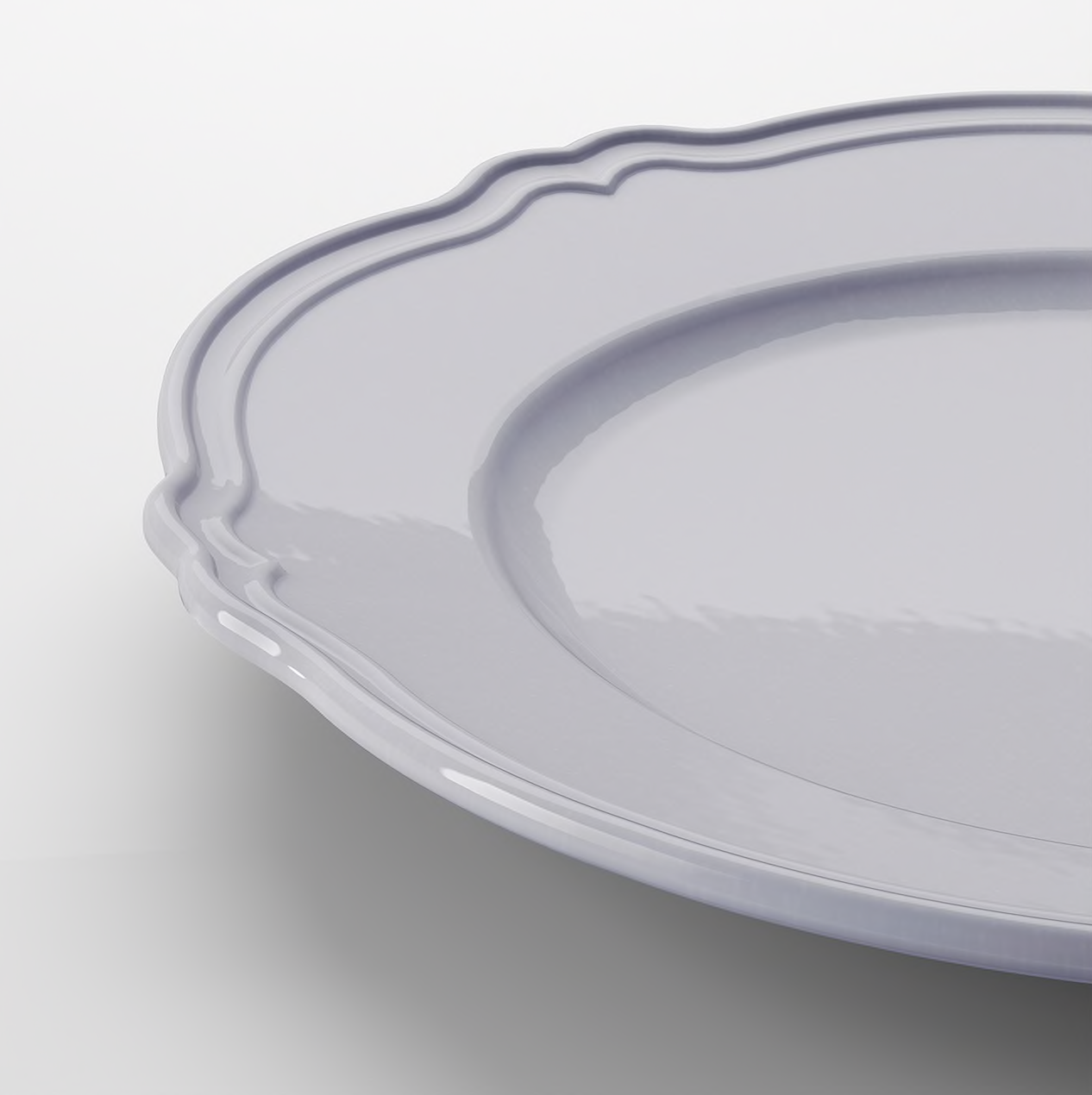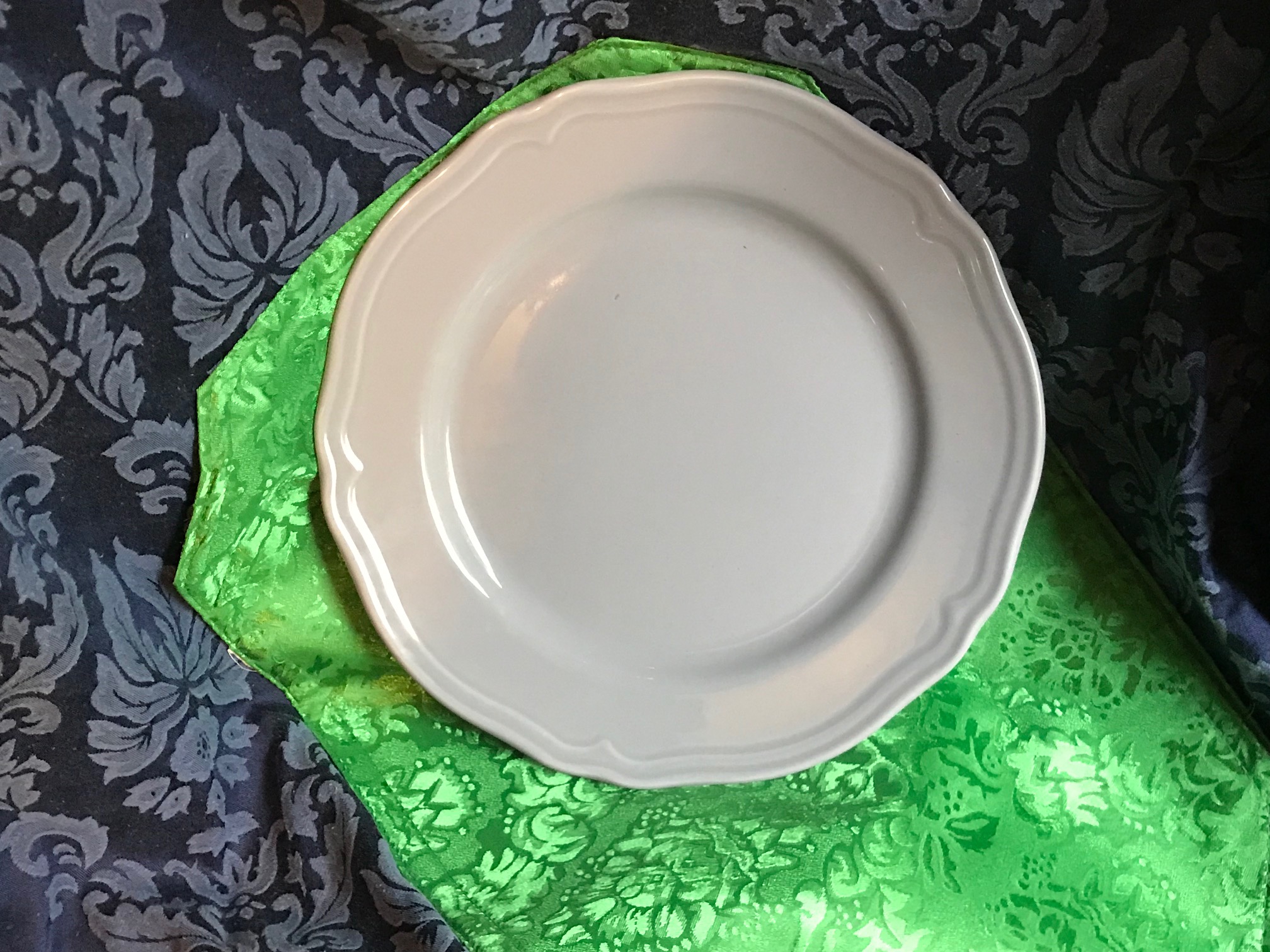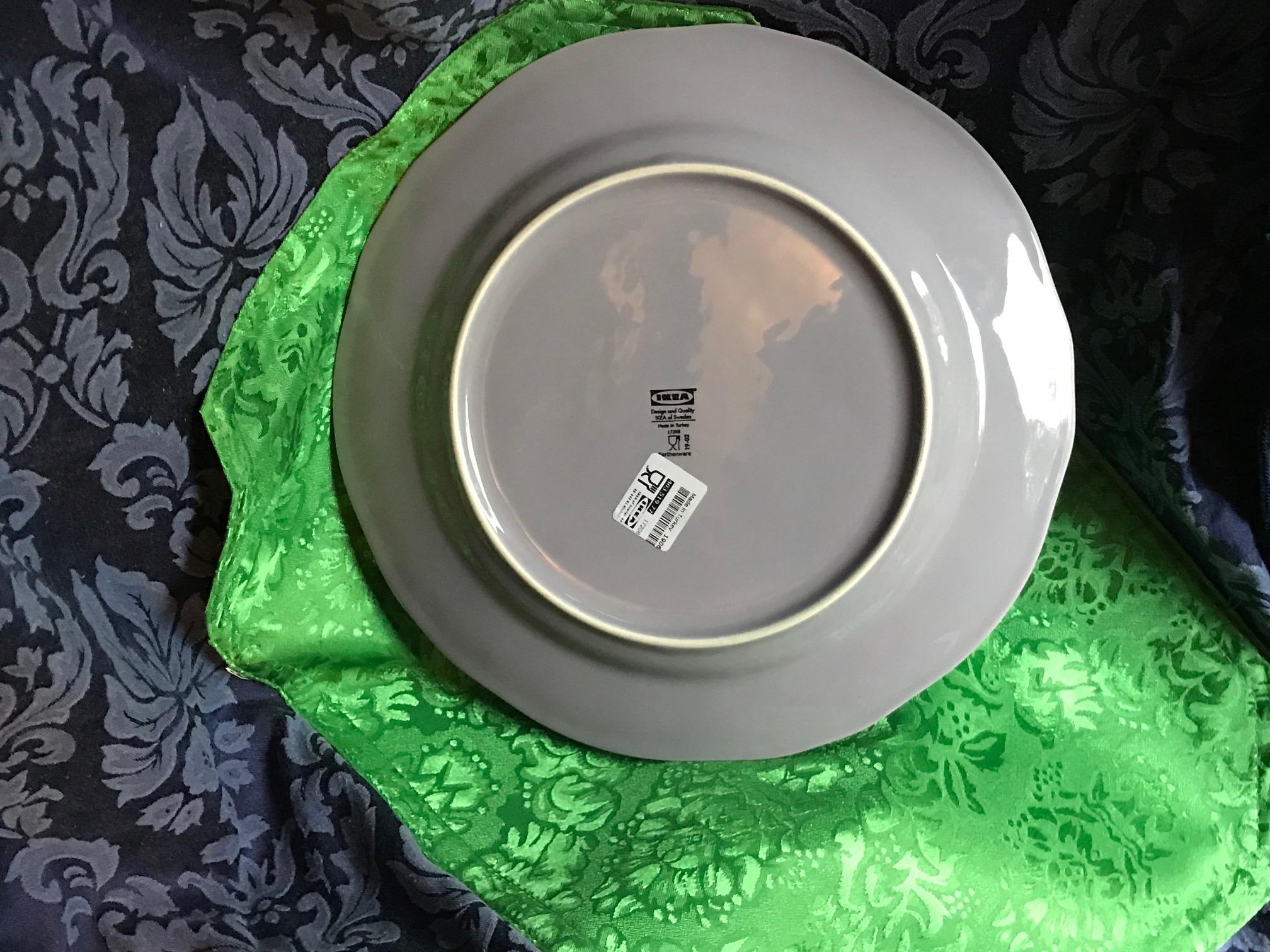2019 Ikea Brand, Made In Turkey – Lilac Arv “Ruffled” Dish: 341 ppm Lead + 34 ppm Cadmium (Read full post for details.)

Background on my work testing Ikea products since 2009:
Since I get so many *Ikea* questions (and since I have long-recommended Ikea as a great general-purpose go-to brand), I decided to purchase some new, current Ikea plates myself, and post their test results here on the blog. With much of what I test and report on here on the blog being used items sent in by my readers, I don’t always know the date of manufacture, or the date of purchase – and often I also don’t know the manufacturer’s exact model number or color name (or pattern name). By purchasing some of these Ikea offerings brand-new at the store myself (in September of 2019), I can give my readers a definite picture of Ikea’s current offerings, and confirm whether or not they have Lead [and if they do, what the levels are].
In the past 10 years, Ikea has generally been a safe choice.
If you have been following my work for much of the 10+ years I have been doing (and reporting on) consumer goods testing (using XRF technology), you have probably read some or all of the following statements typed by my fingers:
- Nearly all Ikea products I have tested in the past 10 years have been either Lead-free or Lead-safe.
- By “Lead-safe” what I mean is that any Lead detected is within a “safe range” by the current best (European and U.S.) standards.
- Safe range is determined both by the level of Lead detected (taking into account the margin of error of detection) and the intended use of the product.
- NOTE: Prior to 2010 there are definitely examples of high-Lead Ikea items; please click this link to see one of those.
Overall, what were the results of the testing of new (2019) Ikea products?
Over the next day or two I will be posting more than 10 new (September, 2019 purchased) examples of Ikea products, with their XRF test results. While several of these examples are completely Lead-free, I want to mention (in this summary that I am including with each one of these posts) that some of these items have tested positive for a low-level of Lead [a level that is a fraction of what I find in most older dishes – but still slightly higher than what I would strictly consider to be in the “unquestionably Lead-safe” range]. As a result of these new findings, I intend to make periodic trips to Ikea to purchase more new examples and colors of their products so consumers can have a better sense of which NEW Ikea items are definitely either completely Lead-free, or Lead-safe.
Additionally, with each of these posts – as the items have been purchased new – I will be including photos of the back side of the item with the store label with the identifying model number and other relevant information, so my readers can make choices for their homes based on that information.
Important to note:
While some of these products may be positive for trace levels of Lead with XRF testing, I am confident (given Ikea’s use of European manufacturing standards) that they pass any relevant leach testing standards for toxicants at the time of manufacture. As always, my concern for Lead content in dishware is not for what happens when they are new – but what may happen in the long term, with years (or even decades) of regular use — daily use, as intended for food use purposes – including with hot and acidic foods – like coffee, lemonade, salad dressing and tomato sauce, and machine dishwashing, chipping and wear (or breakage), etc. over the years.
What are the exact XRF test results for the dish pictured in this post?
Food surface of the plate (60-second test):
- Lead (Pb): 288 +/- 34 ppm
- Cadmium (Cd): 34 +/- 12 ppm
- Mercury (Hg): Negative / Non-Detect
- Arsenic (As): Negative / Non-Detect
- Antimony (Sb): Negative / Non-Detect
- Barium (Ba): 6,727 +/- 355 ppm
- Zinc (Zn): 25,900 +/- 900 ppm
- Copper (Cu): 212 +/- 62 pm
- Iron (Fe): 1,352 +/- 231ppm
- Vanadium (V): 614 +/- 69 ppm
- Titanium (Ti): 1,417 +/- 125 ppm
- Zirconium (Zr): 12,400 +/- 500 ppm
- Cobalt (Co): 583 +/- 134 ppm
Glazed area on back side of the plate (60-second test):
Area around logo did not have appreciably different readings than those below.
- Lead (Pb): 341 +/- 40 ppm
- Cadmium (Cd): 44 +/- 14 ppm
- Mercury (Hg): Negative / Non-Detect
- Arsenic (As): Negative / Non-Detect
- Antimony (Sb): Negative / Non-Detect
- Barium (Ba): 7,238 +/- 409 ppm
- Zinc (Zn): 28,100 +/- 1,000 ppm
- Copper (Cu): 280 +/- 71 pm
- Iron (Fe): 1,472 +/- 250 ppm
- Vanadium (V): 628 +/- 71 ppm
- Titanium (Ti): 1,488 +/- 132 ppm
- Zirconium (Zr): 15,400 +/- 600 ppm
- Cobalt (Co): 720 +/- 151 ppm
Unglazed rim on the backside of the plate (60-second test):
- Lead (Pb): 203 +/- 27 ppm
- Cadmium (Cd): Negative / Non-Detect
- Mercury (Hg): Negative / Non-Detect
- Arsenic (As): Negative / Non-Detect
- Antimony (Sb): Negative / Non-Detect
- Barium (Ba): 6,900 +/- 322 ppm
- Zinc (Zn): 12,500 +/- 500 ppm
- Copper (Cu): 151 +/- 53 ppm
- Iron (Fe): 3,766 +/- 333 ppm
- Vanadium (V): 1,156 +/- 90 ppm
- Titanium (Ti): 2,774 +/- 179 ppm
- Zirconium (Zr): 7,545 +/- 251 ppm
- Cobalt (Co): 379 +/- 131 ppm
All [2019] tests reported on my blog are done for a minimum of 60 seconds per test (unless otherwise noted), using a freshly-calibrated XRF instrument, testing in “Consumer Goods” mode. Testing is always repeated in each instance to confirm the results. Results are science-based, accurate (within the margin of error noted), and replicable. Metals not listed were not detected by the XRF in Consumer Goods mode.
Conclusion:
I would consider this dish to be slightly outside of the “Lead-safe” range — and it is also quite concerning that the dish is positive for trace Cadmium as well (but not unexpected, given the color of the glaze, and the fact that the Cadmium level is within “safe range” by all current relevant standards.)
As Lead was detected on the glazed surface at levels slightly higher (at 341 ppm) than the Lead on the unglazed base ceramic (203 ppm on the rim on the back side of the piece), it appears that the glaze on this piece may, in fact, have traces of Lead as well (in addition to the Lead in the base ceramic.) It was actually test results on a Lavender-colored Ikea piece I tested recently that inspired me to undertake this particular experiment of testing new Ikea dishes.
As a matter of principal, I would personally not select these particular dishes for my home, but if you served me food on them when I was visiting your house, I would not be too concerned (especially if they were new and did not show any wear.) Again, the concern with any amount of Lead in dishware is what could potentially happen over the long-term, from heavy use, wear and abuse/mishaps, etc. You can read more about that on this post – link. It is my personal opinion and stand (more based on ethics and politics than based on the small amount of Lead in any one dish at these levels) that there should be no Lead at all in any dishware, which is why I choose to use undecorated, plain white glass (or clear glass) dishes in my home.
To see the dishes I use every day with my family, click here.
Overall, I still consider Ikea a great brand — however, I stick by my general philosophy when it comes to dishware that I feel confident to have kids eating off of daily: dishes should be simple and plain, decorated only with the food you serve on them – not with glazes, paints or other decorative coatings. That is your best bet, across the board.
I am not particularly enthusiastic about (the quality or durability of) Ikea furniture, but their stainless pots and pans tend to be low-nickel (which is a good thing and preferred by many consumers), and their ceramics and glassware still skew to mostly being Lead-safe or Lead-free (with exceptions like this one, where the consumer really has no way of knowing the difference between this and others.)
To see more Ikea products I have tested, click here.
As always, thank you for reading and for sharing my posts.
Please let me know if you have any questions.
If you appreciate the work I do (especially the consumer goods test results that I report here on this blog), please consider making a small contribution to help cover the costs of these types of (unfunded / unsponsored) posts. Here’s the “Chip-In” link with a bunch of different ways to contribute. Here’s a post with all the different ways you can hire me (an even better way to help support what I do!)
Tamara Rubin
#LeadSafeMama
Ikea glazed ceramic plate model: 403.519.77
17208 • Made in Turkey

Never Miss an Important Article Again!
Join our Email List






Did you buy any of the new upplaga from Ikea? We are looking to replace our vintage china made in Japan (harmony house brand) asap. Looking at safe ikea options!
Hi Rae,
link or picture please?
Thanks.
Thank you! This is the brand new upplaga dish series ikea has out: https://www.ikea.com/us/en/search/products/?q=upplaga%20series
Also, did you test any of the white Arv dishes or just the colored ones in this post?
Just wanted to check to see if you had purchased the upplaga dish series? https://www.ikea.com/us/en/search/products/?q=upplaga%20series
I’m also curious about the upplaga dinnerware series.
I am also very interested in the UPPLAGA series from IKEA. Attached is the link for the basic set https://www.ikea.com/us/en/p/upplaga-18-piece-dinnerware-set-white-00443804/
Thank you for all of your work and research. Our family is also looking to replace decade old plates and would like this set if it would be safe for us.
Hi Tamara,
Thank you so much for your site and work that you are doing.
Just bought my first home and am currently in the process of researching and shopping around for all things! Came across your site when looking into the Johnson Brothers Devon Cottage crockery range – not 100% sure about it now, however it seems the latest manufactured products under FISKARS and made in China may be at a safe level. Would still consider purchasing as I see FISKARS have completely discontinued the Johnson Brothers name and range now.
For daily use and to complement the Johnson Brothers set we are also looking at the UPPLAGA set (plain) from IKEA. (Hoping UPPLAGA is lead-free). If you have the chance, may you please XRF test either or both of these sets?
https://www.ikea.com/au/en/p/upplaga-18-piece-service-white-00443804/
https://www.bedbathandbeyond.com/store/product/johnson-brothers-devon-cottage-4-piece-place-setting/1041818183
Thank you from Australia!
Chloe
I just spent the last 3 hours reading your valuable information! Thank you for doing this! I just panicked when I saw this picture. I have these dishes in white from 2018. I can’t seem to find if you’ve tested those or if its just the grey/violet color that is of particular concern.
Thank you,
Erika
Hi Tamara,
Thank you for the work that you do! Have you tested any of the Ikea Upplaga products by now? I was interested in purchasing a new set of dinnerware and checked with your website if they have been tested. Thanks.
Yes I am also interested in upplaga from ikea, pls check it for us. I had eaten on a regular basis from vintage noritake, a set my husband received from his mom when he moved and now I just realized that it had lead. It is the blue heaven collection. On our plates you can’t even see the pattern since we used it for the past 10 year. I had no idea that china has lead in it, I am felling sick only thinking about it. Our family definitely needs the lead levels checked, specially my children . Thank for all you do!!!